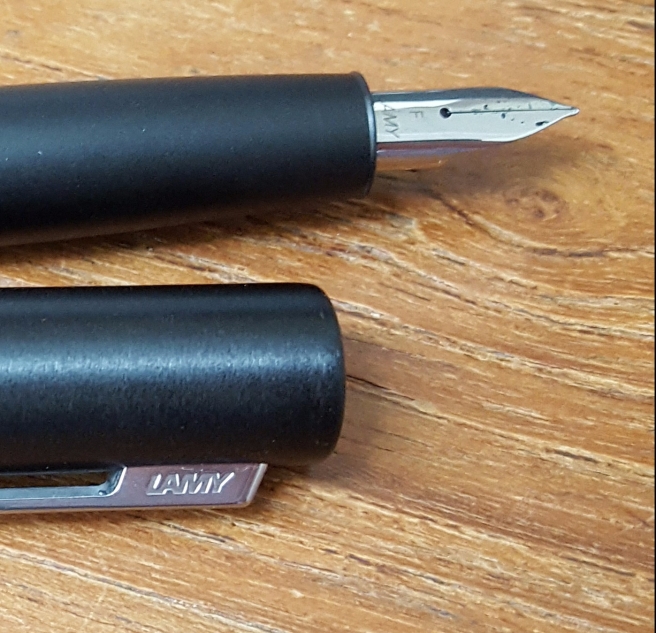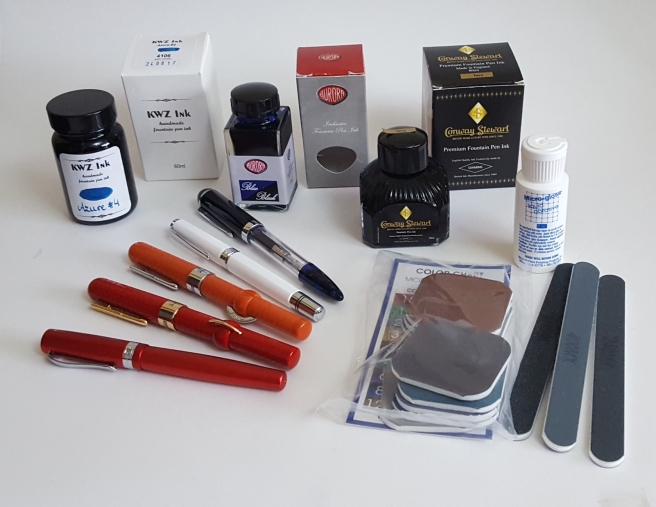I had intended, before the month is out, to write a post or two about the pens that attached themselves to me at the London Pen Show on 1 October 2017. However, normal business has been interrupted by the arrival of the Lamy aion and so today I am instead writing about what is currently on my mind, which is this new beast.
Having come away from the pen show very happily, with five extra fountain pens, the last thing I needed was another pen. Furthermore, I have been using a Kaweco Dia2 a lot lately (which was not one of my pen show pens) and have found myself thinking how super-comfortable and enjoyable it is, such that further pen acquisitions are not necessary.
When the new Lamy aion first came to my attention, I took little interest. But after hearing more about it, I sought out some reviews and spent an entertaining evening in watching several YouTube reviews which sparked further interest.
The anticipation.
I had still not seen one in the flesh. My only concern was that it was an aluminium pen and that in general I am not a fan of metal grip sections. For that reason I had stayed away from the Lamy Studio. After assimilating multiple reviews, I found myself assured that the grip problem had been addressed and decided that the aion was a must have item.
I will not recite what has been said, on Lamy’s official web site and in several online reviews. Suffice it to say that this is a new design, by Jasper Morrison, a modern and un-flashy cartridge-converter pen with strong leanings towards minimalism. Promotional videos showed immaculate, sparsely furnished offices with architects’ drawing boards and angle-poise lighting, into which the modern, minimalist aion blends effortlessly.
Whilst this is good aspirational stuff, I could not help thinking that if my aion is to find itself in a crowded pen cup (or silo of pen cups) with currently well over twenty other inked fountain pens then this is not proper minimalism. But never mind that.
After a few days mulling it all over, I went ahead and ordered one, in black, with a fine nib. I chose to order through The Writing Desk, as their price included the Z27 converter and they test the nibs before despatch.
Waiting for the pen was exciting. I enjoyed thinking what ink to put in and settled on a safe Waterman Serenity blue to start with.
First impressions.
First impressions when it arrived were good. It is a stealthy matte black finish, and feels very robust and a nice weight (32g capped or 22g uncapped). The finish of the cap and barrel is slightly textured, like a very fine grade of micro-mesh. Lamy’s description is “Brushed and blasted surfaces are refined with a brilliant silk-matt anodic coating finish.” (Anodised, means coated electrolytically with a protective or decorative, oxide surface). I particularly like the length, a generous 137mm opened and unposted. It is a comfortable length to use unposted, even for my fairly large hands. I also very much liked the sprung pocket clip; just press the top of the clip and it opens to allow you to slip the pen in or out of a jacket pocket one handed. My Lamy logo clip does this too.
The nib is a slightly different shape from the usual Safari Z50 nibs. The outside edges have a different contour, the shoulders being more rounded, yet the the new nibs are still interchangeable with them.

There are similarities with the Lamy Studio, in the shape of the section. Also, the plainness of the design, an air of undertstatedness, reflects the much admired Lamy 2000 of 1966.
The cap snaps on and off firmly. I think it is secured by the flange at the nib-end of the section, clipping into slots in the inner cap. When capped, the pen can rotate in the cap and there is just a little movement of the pen which can be wobbled from side to side in the cap, but not such as to be a problem. With cap removed, the section blends almost seamlessly into the barrel, with no threads, no step, no slightly tickly cap-fitting lugs. You can hardly see the join, except for the difference in texture.
So, what of the section? Again, it is aluminium. It looks stunning. But what is it like to hold? It has some texture to it but different from the cap and barrel and less grippable. Personally I would have preferred it to have at least the same amount of roughness as the barrel. But I am not a designer, just a user.
The writing experience.
Here, I have had differing experiences. As we know, a pen is held between finger and thumb and rests on your second finger under the section. The nib must be held to the paper at the optimum angle (finding the sweet spot for your nib) and then held consistently as you write. We rely upon being able to anchor the pen with finger and thumb to stop it from slipping and rotating left or right away from the sweet spot.
So, if your thumb cannot get a grip on the barrel or section where it is placed, the pen will slither around. Writing becomes frustrating. You will need frequently to release your grip (such as it is), rotate the pen back to where you want it, and then grip again.
In my case, (remembering that I have had the pen for only a few days) I have found marked differences in how I get on with the pen. This is all down to the moistness of the skin, which seems to vary at different times of the day. If your skin is dry then this pen is hard to hold steady. It feels a bit like the inside of a Teflon saucepan.
But when your skin has a slight amount of moisture, (and it only needs a very little to make all the difference) then the pen can be held steady and writes like a dream. It is nicely weighted towards the front end. The nib needs no pressure at all. The pen writes effortlessly under its own weight and you just guide it along.
I should mention that I tried Serenity blue ink at first but later flushed this out, gave the pen a good rinse and then refilled with Conway Stewart Tavy, by Diamine which is a nice blue black, that I like. I have noticed that sometimes ink starvation occurs a couple of paragraphs in which is just due to the ink staying at the far end of the converter and this is easily remedied by a light shake and then all is well.

I think the pen likes to be held with a light touch. I keep having to stop myself from gripping it too tightly. Once you learn to let go a little and let the pen do its thing, then it is a joy to use. But it all depends on the degree of moisture in the finger and thumb!
If all this sounds too much trouble then it is wise to get some hands-on experience of the pen before buying. Or some moisturiser.
As a final thought, after just a couple of days use, when picking up my super-comfy, perfectly sized Kaweco Dia2, I felt that the latter was a little narrow in the grip. So how the aion feels will also depend on what you are used to. Here they are together.








